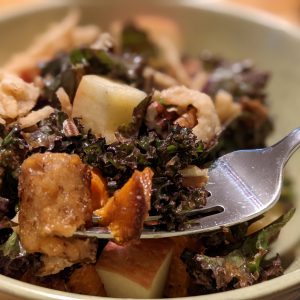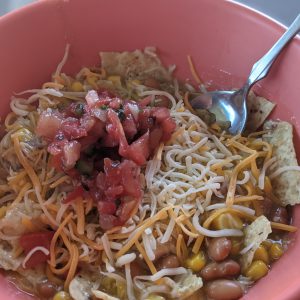
Dutch oven cooking can be intimidating. We got one for a wedding gift and it was quite a while before we could do more than a cake-mix-and-canned-peaches cobbler. Now it’s our favorite way to cook while car camping (not backpacking for obvious reasons) or on a hot summer day to keep the house from heating up. Let’s try to demystify it a little.
Tools of the Trade
To have a successful experience cooking in a dutch oven you’ll need a few things. I tried to leave out the unnecessary stuff.
Dutch Oven – This is the most expensive part, but you should only have to buy it once since they last forever if you take care of them. And when I say forever I mean like it’ll be useful long after you’re gone. You want the kind that have the legs to keep it up off the coals. The kind without legs are meant for the oven in your house, but you can always use the legged ones in your house oven anyway, so you might as well just buy the one kind. Most new dutch ovens come pre-seasoned which is nice. Lodge seems to make a good one.
Charcoal – You’re going to need something to burn. In theory you can use some coals from your campfire, but briquettes are going to be so much more consistent and reliable. Usually I’m all about buying generic brands when possible, but this is one where you’ll want to get the good stuff. I have had some bad experiences with the cheapo kind. You can usually find two packs of Kingsford charcoal (2 x 20lb bags) on sale at Home Depot and Lowe’s around most major summer holidays (Memorial Day, 4th of July, Labor Day) in the $10-13 range. I usually stock up during these sales.
Charcoal Chimney – A charcoal chimney is simply the fastest and most consistent way to get your charcoal ready to cook. You don’t need lighter fluid — ever. Dump your charcoal into one of these, crumple up a piece of newspaper and shove it in the bottom, and light ‘er up. In half an hour you’ll have a bin of charcoal all ready to go.
Metal Tongs – Please get these. They’re cheap and will keep you from burning yourself when you try to move charcoal with sticks.
Lid Lifter – This one is pretty necessary to lift the lid off your dutch oven when it’s hot and covered in ashes. It allows you to take it off without burning yourself (recognizing a theme here?) and stabilizes it so you won’t be spilling the ashes in the meal you’ve put so much effort into.
Leather Gloves – Keeps you from burning yourself. With all the other tools above it’s not absolutely necessary but nice unless you were hoping to get rid of some knuckle hair anyway.
Pot Scrapers – These little pieces of plastic are a miracle. You’ll find yourself using them on all your pots.
Light My Fire
First you need a location. Generally this happens in a fire pit of some sort. You’ll want to clean out any ashes that might smother your briquettes. You can also do this on concrete or asphalt if you need to. Just be safe.
Before you start prepping food, get out your charcoal chimney and light the charcoal. It will take half an hour or more before it’s ready to cook with. Charcoal chimneys are super easy to use. Just pour in the charcoal, crumple up some paper underneath, light it, and wait. When the charcoal on top has spots of grey ashes, you’re ready to go. If your particular dish needs to cook for longer than an hour, you probably want to get a second batch going while the first is cooking your food.
Then at this point you smile, kick back, and read a good book for a while because you have all your ingredients pre-measured and mixed in ziploc bags. If that’s not the case this is a good time to start chopping or mixing things.
Get Cooking
A common rookie mistake made when you’re hungry is to get your dinner in the dutch oven and then pile on all the charcoal you have hoping that it will get dinner in your belly faster. All that will do is get the bottom and top burnt and the middle undercooked. Think of each briquette you add as turning up the dial on the oven in your house. You wouldn’t bake cookies at 500 degrees, would you? When deciding on and placing the briquettes, you will want fewer of them on the bottom than on the top. A good rule of thumb is to take the number on the lid of your dutch oven (a.k.a. the diameter in inches, ) and put that number minus two underneath in a circle. Then take the diameter (number on top) and add two and place them on the lid.
So a 12 inch diameter oven would have 12 – 2 = 10 underneath and 12 + 2 = 14 on top. Easy peasy. If that’s too hard, many good dutch oven recipes such as the ones I link to below from Byron will give you the number or briquettes to place on top and underneath.
As the food is cooking. Try not to pull the lid off too often to check it as that lets all the heat out and will make the food cook slower. It does help to have a cleanish rock to set the lid on while you’re checking things though, so scope that out before you take the lid off. Do rotate the dutch oven and lid every 10-15 minutes to make sure everything cooks evenly. I like to set a timer on my watch to remind me.
Ready to Eat
When it’s all done get your leather gloves and/or lid lifter and grab the handle for the dutch oven and lift the entire oven off the hot coals to stop the cooking. To get the coals off the top, carefully lift the lid with your lid lifter keeping it horizontal so as not to spill ashes into your dinner. Then tilt it and dump the charcoal and ashes back into the fire pit. A little tap on the side of the pit or a rock can persuade the last of the ashes to vacate the lid.
Eat
You’ve earned this.
Cleanup
Give these instructions to whoever owes you for making them such a wonderful meal:
Use your scraper and hot water to clean out all the food bits in the dutch oven. Dry it completely. Get a little bit of cooking oil on a paper towel and wipe it down. This keeps the seasoning going.
See also
Seven Secrets of Dutch Oven Cooking – Some great additional tips for dutch oven cooking. I got my formula above for the number of briquettes from here. He also has instructions for seasoning a dutch oven although I’d probably do it on my grill outside instead because it will get smoky.
Byron’s Dutch Oven Recipes – He knows his stuff. You could buy a book of dutch oven recipes or you could just use his and have better results.











[…] Note: Due to the amount of sugar in the crumb’s crust it is important to rotate the oven and lid every 10 minutes to avoid generating hot spots which can cause uneven browning. PS Need a review on dutch oven basics? Check out our post here. […]